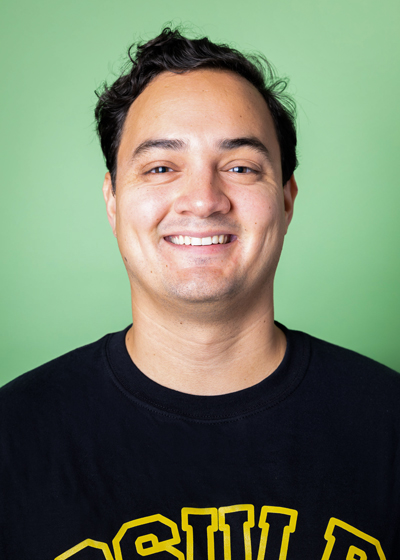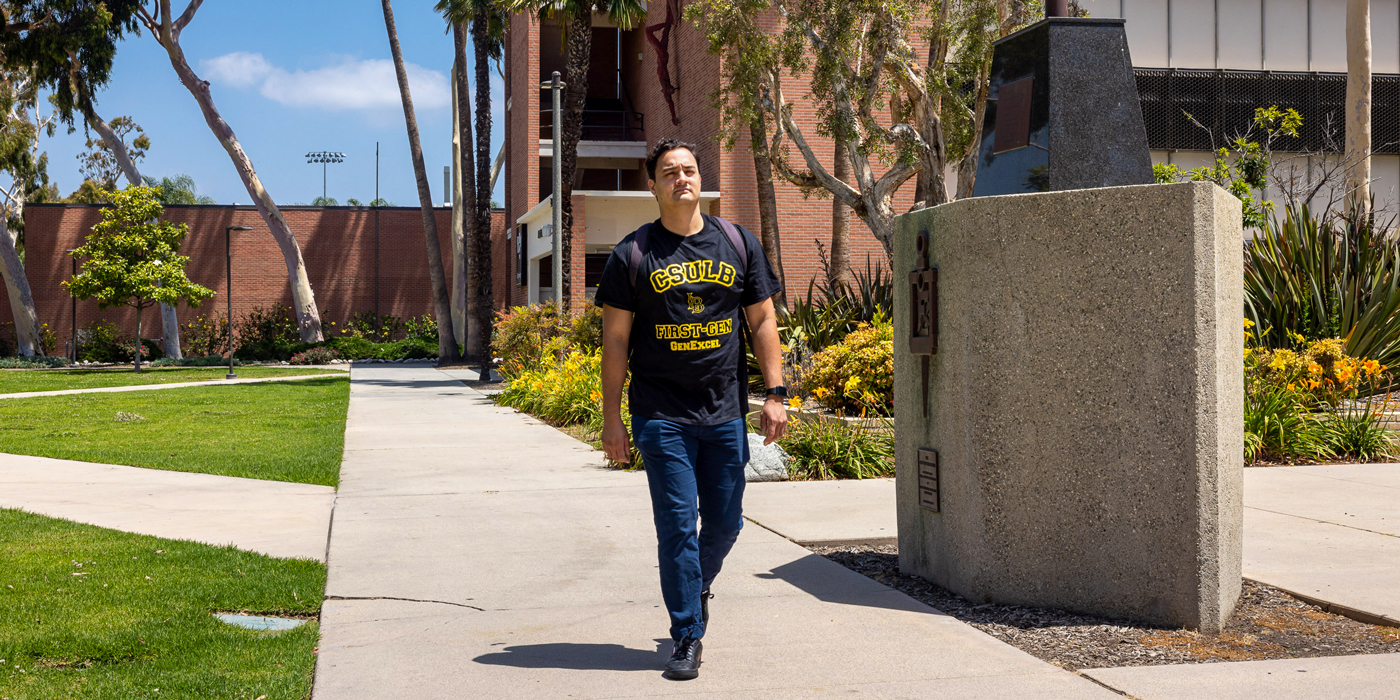In an effort to not only increase graduation rates, but eliminate persisting equity gaps that affect underrepresented students, the California State University adopted five
Graduation Initiative 2025 equity priorities in fall 2021:
- Reengage and reenroll underserved students
- Expand credit opportunities with summer/intersession
- Ensure equitable access to digital degree planners
- Eliminate administrative barriers to graduation
- Promote equitable learning practices and reduce DFW (D-F-Withdraw) rates
As part of a series looking at the GI2025 priorities, this second installment delves into how digital degree planners and roadmaps help students plan their course loads and ensure they’re on schedule for an on-time graduation.
“The digital degree planners give students confidence that they're on the right track to graduation as they start their courses of study, whether they're incoming first-time, first-year students or transfer students,” says Kerry Johnson, Ph.D., associate vice president for Undergraduate Studies at
California State University, Long Beach. “They fill in gaps and provide extra support that students can access easily without having to necessarily make an appointment with an advisor. Students can answer some of their own questions with it: Am I on track? Is this class the right one? Is this in the right order? Am I taking this in the correct semester? Did I take the prerequisites when I was supposed to? It certainly isn't a substitute for advising, but it's an important and useful supplement.”
‘What-If’ Scenario
 "As a transfer student, the planner made me feel reassured that I can plan out my schedule and know the definitive classes I need to take." —Jose Campos Ramos
"As a transfer student, the planner made me feel reassured that I can plan out my schedule and know the definitive classes I need to take." —Jose Campos Ramos
When senior Jose Campos Ramos transferred to Cal State Long Beach as a computer engineering major in spring 2020, he was coming from a community college experience where he needed to meet with advisors—who often changed—multiple times a semester to make sure he was enrolling in the correct courses. Even then, he ended up taking extra courses he didn’t need, extending his time at the school. Having access to Cal State Long Beach’s digital degree planner helped smooth his transition and determine his plan of action.
“As an incoming student, you're overwhelmed with what classes to take,” Campos Ramos says. “Having the degree planner when I got here relieved a lot of stress about the classes and the extracurriculars I'm going to take, and [allowed me to] not have to see an advisor so often.”
Cal State Long Beach first adopted its digital degree planner platform in 2014. Currently, about 95 percent of CSULB students use the planners in tandem with the academic requirements report (degree audit) to ensure they are on track to complete all requirements needed for graduation.
“It's a dynamic tool that presents four-year plans for first-time, first-year students, as well as two-year plans for our transfer students,” says Meghan Griffith, CSULB university registrar. “The idea is, from early on, they're seeing that roadmap to graduation, so that—combined with other eAdvising tools, sessions with their advisors, all things needed for that success—ideally it's going to help prepare students to be on track to meet their graduation needs.”
“Students are coming in with all sorts of levels of literacy when it comes to navigating higher education,” Griffith continues. “In no way does the planner replace an advisor … but it demystifies some of those different things in navigating that pathway to graduation. The student can interact with it, and it hopefully helps them feel a little bit more prepared when they meet with their advisor.”
When students access
the planner, they will see the classes they need to fulfill their general education and major requirements organized into semesters based on factors like class availability, prerequisites needed, transfer credits and classes completed. The classes will reshuffle across semesters if students don’t get into a certain class or take fewer or more credits.
“I liked the ‘what-if’ scenario the degree planner has, if I were to take a class later, shorten my [number of] semesters or allow more credits,” says Campos Ramos, who is planning to graduate in fall 2022. “The biggest benefit was to see how my career at Long Beach could be shortened or lengthened by being part-time or full-time.”
The dynamic planners exist for all the campus’s undergraduate majors, pre-majors, minors and certificates—as well as some graduate and postgraduate programs.
Steps to Enrollment
At
California State University San Marcos, which began testing its platform in 2015, the “Degree Set Go” campaign relies on the campus’s digital degree planner to guide students through a
three-step enrollment process. The campus has the planner built out for all undergraduate programs based on four-year roadmaps, and 98 percent of students use it.
“The planner is a better way to illustrate to students what their path to graduation might look like,” says David McMartin, director of the CSUSM Office of Academic Advising. “They have access to the degree planner 24/7. It's an important part of how students get ready for the coming semester as well as future semesters. They're using it as their guide to know what courses to take and when to take them, and it's also their way to proceed forward in the enrollment process.”
“Because the planner is associated with those four-year roadmaps, it automatically shuffles a student’s future plan once they've registered for their classes after the semester begins,” McMartin continues. “This means that if the student doesn’t get into the classes the degree planner suggested, they take more units than originally planned or they take fewer, the degree planner is going to account for that student’s actual enrollment. The degree planner is always going to pay attention to what priority the next semester courses have for them, especially taking into account prerequisites. This ensures the courses cannot be taken out of order.”
Here’s how CSUSM’s “Degree Set Go” works for students:
Degree: First, students log into the degree planner and indicate the number of units they plan to take the following semester. Many students leave the default setting of 15 credits per semester, but others can opt to take fewer or more courses. The tool will automatically arrange their classes based on their responses.
Set: Once the semester’s class schedule is available, students will return to the degree planner to make course selections. The planner indicates which classes are mandatory and features a select line for requirements that can be met by multiple courses from which students choose a qualifying class to take. Students will use the schedule assistant tool that works in tandem with the digital degree planner to pre-load their courses into their ‘shopping cart.’ The tool allows students to add times and days they are not available to take classes, and the planner generates personalized potential schedules based on their choices.
Go: Finally, students go to their ‘shopping cart’ to complete the enrollment process on their scheduled enrollment date.
 "I’m in my senior year now and I don’t have any worries about what I’m going to be taking ... because I already have it all figured out," —Tyrone Totten
"I’m in my senior year now and I don’t have any worries about what I’m going to be taking ... because I already have it all figured out," —Tyrone Totten
“The planner helped me because I was able to see a visual of my plan, what courses I was going to be able to take during each semester, what requirements I was going to take, and it helped me organize myself,” says Tyrone Totten, CSUSM child and adolescent development senior. “It allows students to understand their academic journey, helps students graduate on time and keeps them on track.”
For Totten, who returned to CSU San Marcos in fall 2021 and plans to graduate in spring 2023, the planner was particularly helpful in notifying him when his course requirements changed and reducing the number of classes he needed to complete.
“When I was able to see different classes that double counted for requirements, it decreased the time I needed to be at school,” Totten says. “For example, I was going to take four or five classes for my last semester in spring 2023. But after going over my degree planner and seeing what requirements each class covers, I only have to take two classes my last semester. So, it helps you be more efficient as a student.”
Highly Trained
Part of ensuring such high use rates among students is getting them acquainted with the technology through communications efforts, advisors, online resources and various training opportunities.
“We always have a new crop of students, so we've created an enrollment tutorial in which students always have access to the training they need,” McMartin says. “This is a way of making sure students, when they first start at the university, have access to understanding how to use the tools—so that we start everybody in the same place in terms of what it's about, what the advantages are and how to make good use of these kinds of tools.”
In addition to these resources, student peer advisors like Totten who serve in the CSUSM advising office can answer questions around registration and enrollment, including questions on the digital degree planner.
“When you call the academic advisory office, we're the first people you interact with,” Totten says. “We get questions about the degree planner or what classes students should be taking. So, as a peer advisor we help students go through the degree planner … and see what courses they're able to take for each requirement.”
 "The school did a great job with the advisors sharing their opinion with us on the planner and how to navigate through it because it does take a while to get used to it." —Jose Campos Ramos
"The school did a great job with the advisors sharing their opinion with us on the planner and how to navigate through it because it does take a while to get used to it." —Jose Campos Ramos
Equipped and Ready
For the campuses, the planners also provide a plethora of data to drive decision-making and better serve the student body.
“It increases accessibility to actionable data, from timely graduation to student support activities, placing a lot of tangible, informative data in advisors’ hands and higher leadership's hands,” Griffith says. “We do so much work to extrapolate that data … and leverage it as much as possible to help facilitate with future scheduling and strategic initiatives.”
Both Cal State Long Beach and CSU San Marcos use students’ choices in the digital degree planner to determine the course schedule for the upcoming semester, including which courses and how many sections to offer to meet students’ needs.
“It's a very important piece of the puzzle as we try to plan courses for our students in the most appropriate way possible,” McMartin says.
Additionally, advisors access students’ degree planners to better equip themselves to guide students on choosing and enrolling in classes.
“It helps the advisor because they can be on the same page [as the student] much more quickly,” McMartin continues. “We can start our advising sessions at a much earlier stage without having to research a lot of information concerning their requirements.”
Looking Ahead
“We're always looking for ways to work with the colleges and Enrollment Services to improve the digital degree planner and to make sure it's as accurate as possible,” CSULB’s Dr. Johnson says. “That's an ongoing process.”
Beyond ironing out challenges with the technology, that process involves updating the planners on an annual basis with changes to major curricula, new general education requirements and new programs.
A number of CSU campuses, like
California State University, East Bay, however, are still working to procure the digital degree planner platform. Since switching to a semester system in 2018, though, Cal State East Bay has offered
degree roadmaps, available for all undergraduate programs, that students can access online and use to plan their path to graduation.
“It was important that each of our students had a roadmap, so they could see how they could complete their degree in four years for our first-time freshmen—as well as a roadmap for our transfer students, so they can finish in two years,” says Maureen Scharberg, Ph.D., CSUEB dean of Academic Programs and Services. “It's like their GPS device. It tells them what we as a campus see as important in terms of the sequencing of courses.”
 "The roadmaps are used as a tool for advising. Our advisors can work with a student by bringing up the roadmap and looking at a specific major. ... The goal is to provide students with that pathway so they can complete their degree." —Dr. Maureen Scharberg, CSUEB dean of Academic Programs and Services
"The roadmaps are used as a tool for advising. Our advisors can work with a student by bringing up the roadmap and looking at a specific major. ... The goal is to provide students with that pathway so they can complete their degree." —Dr. Maureen Scharberg, CSUEB dean of Academic Programs and Services
The campus continues to update the roadmaps each year with new degree requirements and majors. While currently used largely as an advising tool, these roadmaps will provide the basis for the digital degree planners when CSUEB implements them.
"Since technology has advanced since 2014, the CSU Chancellor's Office is actively working on procuring a modernized, accurate and mobile-friendly digital planner toolset that works for all students," says Liz Reed, assistant director of Enrollment Management Technology at the CSU Office of the Chancellor.